- Preferences


Agenda Setting Theory - PowerPoint PPT Presentation

Agenda Setting Theory
Agenda setting theory maxwell mccombs and donald shaw agenda-setting hypothesis - what causes what the mass media have the ability to transfer the salience of issues ... – powerpoint ppt presentation.
- Maxwell McCombs and Donald Shaw
- The mass media have the ability to transfer the salience of issues on their news agenda to the public agenda.
- i.e. We judge as important what the media judges as important.
- Two types of agendas
- Media agendas pattern of news coverage across major print and broadcast media as measured by the prominence and length of stories
- Public agendas The most important public issues as measured by public opinion surveys.
- Who is most affected by the media agenda? - Those individuals who have an index of curiosity ( need for orientation ) are motivated to let the media shape their views.
- (Example if I am an animal lover, stories on animal abuse catches my attention.)
- The media arent very successful in telling us what to think, but they are stunningly successful in telling us what to think about.
- Framing the selection, emphasis, exclusion and elaboration of the news content by the media
- i.e. the media tells us what is important and is selective in reporting only the content dealing with the selective points of the content.
- Example John F. Kennedy was continually reported on as youthful vigor but his extramarital affairs were hidden by the press corps.
- Current thought is The media may not only tell us what to
- think about, they also may tell us how and what
- to think about it, and perhaps even what to do
- Perception Model
- Source Prof. Frank Brettschneider, University Höhenheim, Germany
- Research has shown connections between media agendas and opinion.
- Interesting behaviors can be predicted after certain media priorities.
- Examples a reduction in travel by air and an increase in flight insurance after reports of airplane crashes.
- Professional sports benefit from media
- Scheduling games during prime time
- Players are idolized
- Numbers of games increase
- Monies paid to the professional sports organizations (NBA, AFC, etc) has grown exponentially providing an agenda for a business plan
- A handful of news editors are gatekeepers of political dialogue
- Operations chiefs of Associated Press
- The New York Times
- The Washington Post
- ABC, NBC, CBS, CNN, Fox and MSNBC
- Candidates and Office Holders themselves
- Interest aggregations - clusters of individuals who demand center stage
- Compelling news events that cannot be ignored
- Online reading of newspapers vs. print newspapers study
- Print readers retained more content
- Selection of issues are more important to individuals and align them to a prioritized agenda
- New technologies create a more personalized information environment that curtails larger flows of public information
- Age differences create preferential media choices
- Young adults deem late-night comedians and the parodies may determine importance of issues in the media
- 1. If the media arent telling you what to think, why is their ability to tell you what to think about so important?
- 2. What dominant set of attributes could you use to frame an individuals point of view? Example What attributes of a teacher could a student use to frame how the teacher is perceived by the student? Why might this be important in teacher evaluations?
- Is there a recent issue that reporters and commentators are talking about that you may not care about? Do you think you still may not care about it two or three months from now?
- Griffin, E. A. A First Look at Communication Theory. 2012.
- McGraw-Hill Companies, Inc.
- Educational Video Agenda Setting Theory. Accessed 11.12.11 http//communication-theory .com/archives/130
- Media Tenor Website. Accessed 11/12/11. http//www.mediatenor.com/smi_AS_approach.php
PowerShow.com is a leading presentation sharing website. It has millions of presentations already uploaded and available with 1,000s more being uploaded by its users every day. Whatever your area of interest, here you’ll be able to find and view presentations you’ll love and possibly download. And, best of all, it is completely free and easy to use.
You might even have a presentation you’d like to share with others. If so, just upload it to PowerShow.com. We’ll convert it to an HTML5 slideshow that includes all the media types you’ve already added: audio, video, music, pictures, animations and transition effects. Then you can share it with your target audience as well as PowerShow.com’s millions of monthly visitors. And, again, it’s all free.
About the Developers
PowerShow.com is brought to you by CrystalGraphics , the award-winning developer and market-leading publisher of rich-media enhancement products for presentations. Our product offerings include millions of PowerPoint templates, diagrams, animated 3D characters and more.

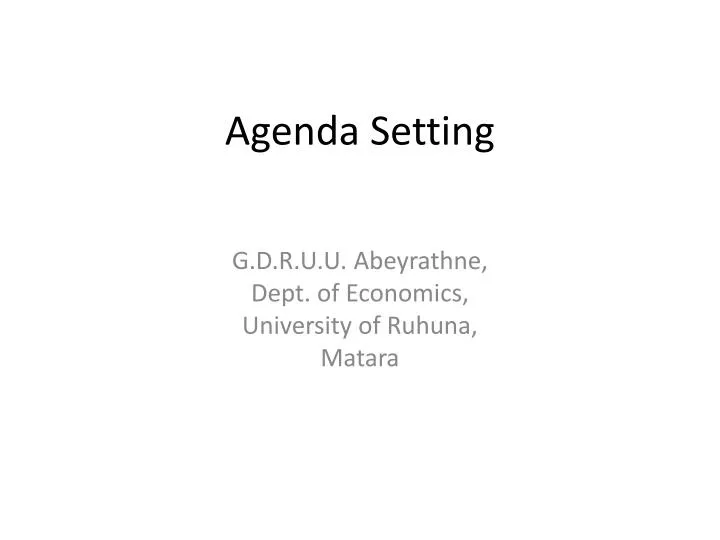
Agenda Setting
Jul 23, 2014
210 likes | 745 Views
Agenda Setting. G.D.R.U.U. Abeyrathne , Dept. of Economics, University of Ruhuna , Matara. Key Terms. Policy Formation: the total process of creating or forming a public policy.
Share Presentation
- comparative political process
- outside initiative model
- policy problems
- american political science review
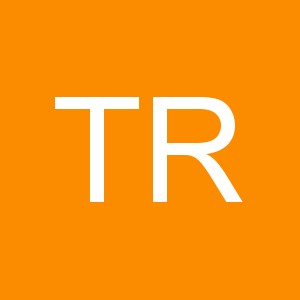
Presentation Transcript
Agenda Setting G.D.R.U.U. Abeyrathne, Dept. of Economics, University of Ruhuna, Matara
Key Terms • Policy Formation: the total process of creating or forming a public policy. • Policy Formulation: It refers to the more discrete stage of adopting a proposed course of action for dealing with a public problem. • Early researchers had concerned much with policy adoption. At present, more attention is paid on how issues get into the agenda
What have they researched? • Why some issues get into the agenda? • Why some issues does not reached to the stage of agenda setting?
Conditions to be met • It has to reach crisis proportions and could not be ignored. • It has achieved particularity. It is the issue exemplifying and dramatizing a large issue such as ozone depletion and global warming. • It has an emotive aspect. That is human interest angle. • It has wide impact.
It raises the question about power and legitimacy • It has to be fashionable. • Agenda setting is set of political controversies that will be viewed as falling within legitimate concern meriting the attention of the polity, a set of items scheduled for active and serious attention by decision making bodies (Cobb and Elder, 1972).
It is the learning of problem by public officials. • Decision to give their personal attention. • The mobilization of organizations to respond to them (Barbara, G. Nelson, 1984).
Nature of Policy Problems • It is a condition or situation that produces need or dissatisfaction on the part of people for which relief or redress is sought (Anderson, 1990, Public Policy Making). • Tractability of some policy problems varies greatly. Some are easy to define. Some are more difficult to define.
Types of Agendas • They are of basically two types. i.e. Systemic Agenda and Institutional agenda • Systemic agenda consists of all those issues that might be subject to action or that are already acted on by the government. These issues can be either pseudo issues or issues discussed just to placate or calm clientele groups but without serious attempt to make serious choices.
Institutional agenda is comprised of those issues that a government has decided to act on seriously (e.g. Legislative calender) It is also known as public agenda as opposed to popular agenda. Thus systemic agenda can be thought of as those issues which are waiting to enter the institution agenda.
Evolution of the Literature on Agenda Setting. • During 1970s, it was thought of as the link between mass participation and elite decision making (Rogger W Cobb and charles D. Elder, “The Politics of Agenda Building” Journal of Politics, 33(4), pp 892-915). • It sought to explain the movement of an issue from popular agenda to public agenda. It was thought that if the audience of the issue is greater, the possibility of entering into institutional agenda also is greater. Social significance and specificity of issue are also important aspects in this regard.
Issues get into the popular agenda on account of 1. Widespread attention 2. Shared concern of a sizable portion of the public 3. Acceptance by the public as proper for governmental intervention.
Clarence Davies Contribution • His work is on “How Does the Agenda Get Set?” 1997) • He has argued that the agenda setting consisted of three phases. • 1. Initiation- public problems creates a demand for action • 2. Diffusion- These demands are transposed into issues for government • 3. Processing- issues are converted into agenda items.
Roger Cobb, Jennie-Keith Rose and March Rose • “Agenda Building as a Comparative Political Process”, American Political Science Review, 70, 1976, pp 126-138. • In that work , they have identified three models of agenda setting. 1. Outside initiative model(It is similar to model discussed above under the Cobb 2. Mobilization Model . Under this models issues are initiated within the government and then enter the agenda 3. Inside initiative model: Issues are initiated internally but are not expanded to the public. Issue supporters desired to keep the issues within governmental area exclusively.
Who set agenda • There are number of explanation on who set agenda. • Elite Perspective • Pluralist Perspective • Sub-government argument.
Sub-governmental Perspective • It assumes the existence of networks of key players in determining public policy. • Key congressional committee members dealing with issues • Agency Bureaucrats responsible for the policy in question • Clientele groups with a stake in the issue (Douglas Carter, 1965, Power in Washignton)
Conditions for evolving a sub-government • A relatively narrow policy field • Specialized congressional committee responsible for that field and differed to and by the rest of the congress • Uniquely equipped interests group and general apathy shown by the public • Relatively autonomous agencies able to cultivate ties outside the executive branch of the government.
- More by User
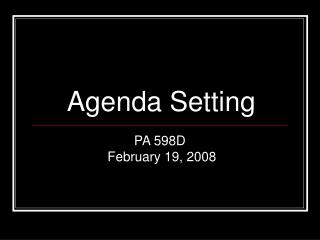
Agenda Setting. PA 598D February 19, 2008. Agenda setting is. The process by which problems and alternative solutions gain or lose public and elite attention.
1.45k views • 26 slides

Agenda Setting. PA 306 Farley Fall 2005. What is an agenda?. “Collection of problems, understanding of causes, symbols, solutions, and other elements of public problems to come to the attention of members of the public and their governmental officials”
530 views • 21 slides
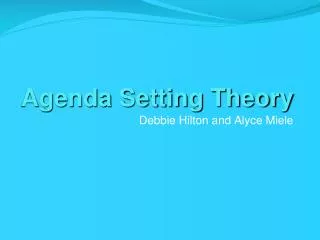
Agenda Setting Theory
Agenda Setting Theory. Debbie Hilton and Alyce Miele . http://www.youtube.com/watch?v=2Ve1_MEMWcA. History of Agenda Setting Theory: Lippmann 1922 . The idea of Agenda Setting began in 1922 with Walter Lippmann’s Public Opinion book.
845 views • 26 slides
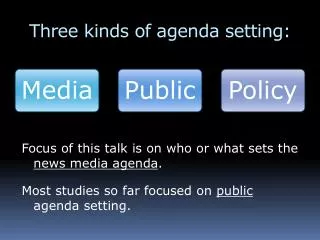
Three kinds of agenda setting:
Three kinds of agenda setting:. Focus of this talk is on who or what sets the news media agenda . Most studies so far focused on public agenda setting. Common to think that journalists set the news media agenda. Several studies question this assumption.
486 views • 22 slides

Agenda Setting Theory. Maxwell McCombs and Donald Shaw. Agenda-setting hypothesis - what causes what?. The mass media have the ability to transfer the salience of issues on their news agenda to the public agenda. i.e. We judge as important what the media judges as important.
3.68k views • 9 slides
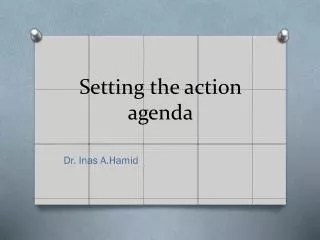

Setting the action agenda
Setting the action agenda. Dr. Inas A.Hamid. It is much tougher to struggle with specific language that will ensure everyone is working in the same direction. Before one can map a course of action for change, it is necessary to answer the question, action for what?
262 views • 12 slides

Setting the local agenda
Cheshire & Warrington 2012 Legacy Conference 11 May 2010 . Setting the local agenda. Chris Brown Chair of the Cheshire and Warrington 2012 Steering Group. Strategic Context in Cheshire & Warrington. Cheshire & Warrington 2012 Legacy Conference 11 May 2010 . Cheshire & Warrington
191 views • 5 slides
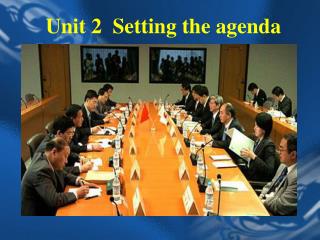
Unit 2 Setting the agenda
Unit 2 Setting the agenda. Objectives. Communication skills: structuring and controlling the negotiation process Culture and tactics: organic versus systematic working cultures Language knowledge: sequencing and linking negotiating practice:
300 views • 10 slides

Agenda Setting Theory. Debbie Hilton and Alyce Miele. http://www.youtube.com/watch?v=2Ve1_MEMWcA. History of Agenda Setting Theory: Lippmann 1922 . The idea of Agenda Setting began in 1922 with Walter Lippmann’s Public Opinion book.
1.54k views • 26 slides
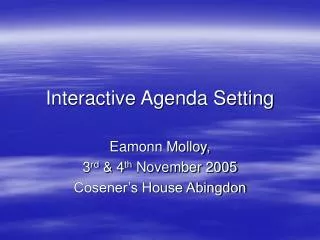
Interactive Agenda Setting
Interactive Agenda Setting. Eamonn Molloy, 3 rd & 4 th November 2005 Cosener’s House Abingdon. Four Types of Interaction. 1. Research. Sa ї d Business School University of Oxford. 4. Benefaction. 2. Teaching. 3. Networking. 1. Research. Project funding Sites of Research / access
224 views • 8 slides

Agenda Setting and Economics
Media and Inflation.
126 views • 4 slides
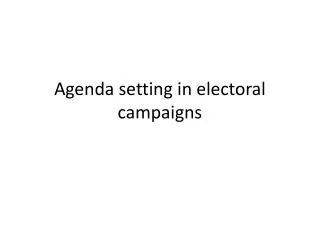
Agenda setting in electoral campaigns
Agenda setting in electoral campaigns. How do people determine what issues, candidate qualities, etc. are important in elections?. By looking to their personal experiences? By asking others? By following the news? By following traditional values and knowledge?
775 views • 67 slides
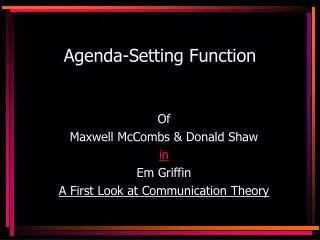
Agenda-Setting Function
Agenda-Setting Function. Of Maxwell McCombs & Donald Shaw in Em Griffin A First Look at Communication Theory. CLICKER. Prior to a short while ago, how likely would it have been for you to discuss something Barak Obama said: A = VERY LIKELY B = VERY UNLIKELY C = MEDIUM LIKELY. CLICKER.
524 views • 35 slides

Agenda Setting. Theory developed by Maxwell McCombs and Donald Shaw in the late 1960s. McCombs and Shaw argued that the “Mass media have the ability to transfer the salience of items on their news agendas to the public agenda.” As they put it :
1.5k views • 23 slides

Agenda-Setting Function. Of Maxwell McCombs & Donald Shaw in Em Griffin A First Look at Communication Theory. CLICKER. Prior to a short while ago, how likely would it have been for you to discuss Barry Bonds: A = VERY LIKELY B = VERY UNLIKELY C = MEDIUM LIKELY. CLICKER.
432 views • 35 slides

Agenda Setting. What is an agenda?. “Collection of problems, understanding of causes, symbols, solutions, and other elements of public problems to come to the attention of members of the public and their governmental officials”
329 views • 21 slides

Agenda-Setting Function. Of Maxwell McCombs & Donald Shaw in Em Griffin A First Look at Communication Theory. CLICKER. Prior to a short while ago, how likely would it have been for you to discuss something Imus said: A = VERY LIKELY B = VERY UNLIKELY C = MEDIUM LIKELY. CLICKER.
409 views • 35 slides

IMAGES
VIDEO
COMMENTS
The agenda-setting theory originated in 1972 when McCombs and Shaw studied the 1968 US presidential election. They found that the issues given prominent coverage in the media were also considered important by voters.
It describes the core assumptions of agenda-setting theory and discusses who sets the media agenda, types of agenda-setting, the effects of media on public agenda, levels of agenda-setting, framing, criticisms of the theory, and conclusions.
The document summarizes agenda setting theory, which describes how the media can influence the public's perception of what issues are important. It discusses the history and development of the theory, including key researchers like Walter Lippmann and Maxwell McCombs.
Agenda-Setting Theory McCombs & Shaw, 1972 ... – A free PowerPoint PPT presentation (displayed as an HTML5 slide show) on PowerShow.com - id: 3e6859-ZGM5Z.
Five Aspects of Agenda Setting • Basic agenda setting effects • Contingent conditions for those effects • Attribute agenda setting • Origins of the media agenda • Consequences of the Agenda-Setting process for people’s opinions, attitudes, and behavior. • Source: (Salwen & Stacks,p.90)
Agenda Setting Theory. Maxwell McCombs and Donald Shaw. Agenda-setting hypothesis - what causes what?. The mass media have the ability to transfer the salience of issues on their news agenda to the public agenda. i.e. We judge as important what the media judges as important.
Title: Agenda Setting Theory 1 Agenda Setting Theory. Maxwell McCombs and Donald Shaw; 2 Agenda-setting hypothesis - what causes what? The mass media have the ability to transfer the salience of issues on their news agenda to the public agenda. i.e. We judge as important what the media judges as important. Two types of agendas
Clusters of people who demand center stage for their one, overriding concern, pressure groups. Who Sets the Agenda for the Agenda Setters? Critique: Are the Effects Too Limited, Is The Scope Too Wide?
Agenda-setting theory posits that the news media determines the issues the public thinks are important by focusing attention on specific topics and influencing perceptions. Research by McCombs and Shaw showed strong correlations between the media agenda and public agenda on election issues, indicating the media influences what the public thinks ...
• Agenda setting is set of political controversies that will be viewed as falling within legitimate concern meriting the attention of the polity, a set of items scheduled for active and serious attention by decision making bodies (Cobb and Elder, 1972).